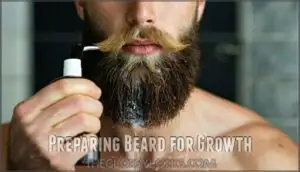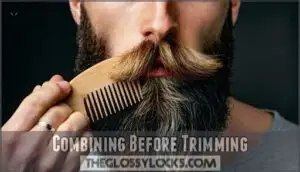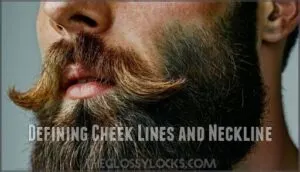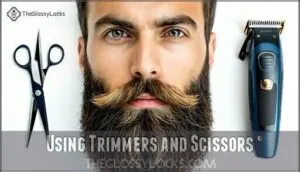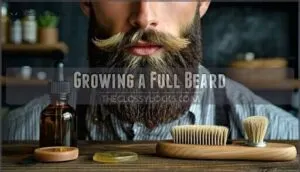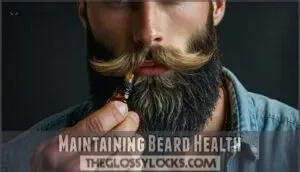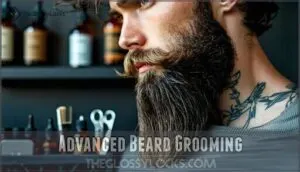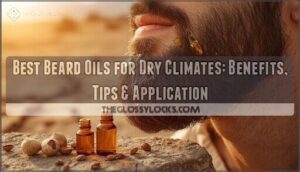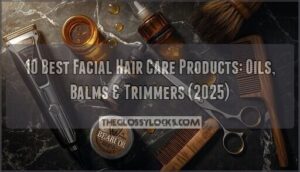This site is supported by our readers. We may earn a commission, at no cost to you, if you purchase through links.

Start by washing and conditioning your beard regularly, then apply beard oil to keep both hair and skin healthy.
Use a quality trimmer to define your neckline and cheek lines while leaving length intact.
Comb your beard daily to train the hair and spot any uneven areas that need light trimming.
Don’t forget to trim stray hairs and split ends with scissors to maintain a clean appearance.
The key is maintaining shape without sacrificing overall length as your beard develops into its full potential, which requires regular maintenance.
Table Of Contents
Key Takeaways
- Establish a consistent grooming routine with daily beard oil application and washing every 2-3 days to keep both hair and skin healthy during awkward growth phases
- Master strategic trimming techniques by defining your neckline and cheek lines while preserving length, focusing on removing stray hairs and split ends with scissors rather than sacrificing overall growth
- Use quality tools and products including boar bristle brushes for oil distribution, wide-toothed combs for detangling, and beard balm for shape control to maintain a polished appearance throughout the growing process
- Train your beard’s growth patterns through daily combing and brushing to guide hair direction, prevent tangles, and identify uneven areas that need light maintenance without compromising your length goals
Beard Growth Basics
Understanding your beard’s growth patterns is essential for effective grooming during the growing process.
Your facial hair follows distinct cycles of active growth, shift, and resting phases, with genetics and hormones like testosterone playing the primary roles in determining your beard’s potential thickness and growth rate.
Your beard’s growth potential lives in your genes, but hormones like testosterone unlock its true thickness and density.
This process is crucial for effective grooming, as it allows you to work with your beard’s natural patterns to achieve the best results.
Facial Hair Growth Cycles
Throughout your beard growth journey, facial hair follows a cyclical pattern with three distinct beard growth phases.
The active growth phase duration lasts two to six months, where follicles produce new hair at 0.27mm daily.
Next comes the intermediate stage details, lasting two to three weeks as growth slows.
Finally, the resting phase impact spans three months when follicles remain dormant.
Hormonal cycle influence and cycle length variations affect this beard growth timeline substantially.
Factors Influencing Growth Rate
Your beard growth rate depends on several interconnected factors that work together like orchestra musicians.
Understanding these elements helps you optimize your grooming routine while supporting natural development.
Key factors affecting your beard growth rate:
- Hormones – Testosterone and DHT levels directly control follicle activity and hair density
- Diet and Growth – Protein, biotin, and zinc fuel healthy follicle function
- Sleep and Testosterone – Quality rest boosts hormone production for faster growth
- Stress Impact – Elevated cortisol suppresses androgens, slowing development
- Exercise Benefits – Regular activity increases circulation and testosterone naturally
Genetic Factors and Ethnicity
Your genetics and ethnicity play major roles in determining your beard’s potential.
Your DNA blueprint determines whether you’ll grow a thick, full beard or struggle with patchy coverage.
Studies show that 77% of beard density comes from inherited traits, with significant variation between ethnic groups.
| Ethnic Background | Typical Beard Density | Growth Pattern | Follicle Characteristics | Genetic Factors |
|---|---|---|---|---|
| Middle Eastern/Mediterranean | Dense, rapid growth | Full coverage | Large follicles | High AR gene activity |
| European | Variable spectrum | Moderate to thick | Mixed sizes | Broad genetic diversity |
| East Asian | Sparse, lighter | Patchy coverage | Smaller follicles | Lower EDAR variants |
| African/Afro-Caribbean | Intermediate density | Curly patterns | Curved follicles | Varied keratin expression |
| Indigenous American | Minimal growth | Light coverage | Fine follicles | Genetic adaptations |
Understanding your Genetic Potential helps set realistic expectations for Beard Density and Growth Hormones response patterns.
Some products, like minoxidil beard serum, can stimulate hair follicles to enhance hair growth and improve overall beard health with high AR gene activity and broad genetic diversity.
Hormonal Influence on Growth
When testosterone levels peak during puberty, they trigger your beard’s initial growth potential.
DHT impact proves more significant than testosterone alone, as this potent hormone creates thicker, coarser facial hair.
Your follicles’ sensitivity to these beard growth hormones determines density more than circulating testosterone levels.
Age influence gradually reduces hormone balance, potentially thinning beards over time through declining dihydrotestosterone activity.
A key factor involves genetic sensitivity to DHT, which impacts beard density.
Preparing Beard for Growth
Growing a healthy beard starts with proper preparation that sets the foundation for ideal growth.
You’ll need to establish a consistent grooming routine that includes washing, conditioning, and using quality products to maintain both your facial hair and the skin underneath, which is crucial for healthy growth.
Washing and Conditioning Routine
How often should you wash your growing beard? Every 2-3 days with specialized beard shampoo prevents over-drying while removing buildup.
Use lukewarm water and gentle conditioning methods to maintain moisture. Choose sulfate-free products with natural ingredients.
Pat dry with a clean towel instead of rubbing. This beard grooming routine establishes healthy washing frequency and proper beard conditioning methods.
Using Beard Oil and Balm
After washing, your beard needs proper hydration to prevent irritation and support healthy growth.
Apply beard oil daily after showering when your pores are open for maximum absorption. Use 4-6 drops for medium-length beards, working from skin to tips.
Many users find quality beard oils improve beard health.
Beard balm provides additional hold and styling control while delivering moisturizing benefits through natural ingredients like shea butter and essential oils.
Combing and Brushing Techniques
After applying beard oil and balm, proper combing and brushing techniques distribute these products evenly while training your beard to grow in the desired direction.
Your comb material and bristle type make a significant difference in achieving professional results.
- Wide-toothed beard comb: Start with gentle strokes for detangling knots without breaking hair
- Boar bristle brush: Follow with downward motions for superior oil distribution throughout your beard
- Styling effects: Brush against growth direction first, then with the grain for volume and shape
- Daily routine: Combine both tools for ideal beard grooming and maintenance results
Trimming for Shape and Length
When trimming for shape and length, you’re sculpting your beard’s foundation while maintaining growth momentum.
Focus on beard symmetry by reducing bulk gradually and defining edges without sacrificing length.
Use trimming techniques that enhance your natural beard styles—trim the neckline two fingers above your Adam’s apple, shape cheek lines conservatively, and address flyaways with precision scissors.
This approach supports styling variations while preserving your beard shaping goals.
Trimming While Growing
When growing your beard, strategic trimming helps maintain shape without sacrificing length. Regular maintenance every 10-15 days keeps your beard looking intentional while allowing natural growth to continue.
Combining Before Trimming
Combing your beard before trimming reveals its true shape and identifies stray hairs that need attention.
This pre-trim prep guarantees detangling benefits while promoting oil distribution throughout your facial hair.
The process helps with stray removal and shape revelation, making your beard grooming session more effective.
Using the right tool helps you maintain beard health.
Proper beard care starts with thorough preparation, setting the foundation for successful beard trimming and maintaining your desired beard styles.
Defining Cheek Lines and Neckline
Clean necklines and cheek lines create the foundation for professional-looking beard grooming shape.
Position your neckline shaping two fingers above the Adam’s apple, forming a U-curve behind your jaw.
For cheek line definition, follow your natural lines rather than creating artificial borders.
Maintaining borders requires precision—trim above existing growth patterns.
A dedicated tool can assist with achieving a clean neckline.
Avoiding over-definition prevents the carved-out look that screams amateur beard trimming techniques.
Trimming Bulk and Mustache
Bulk reduction requires strategic trimming to maintain natural growth patterns.
Use your trimmer with a longer guard setting to remove excess volume from the sides, keeping the chin area fuller for definition.
For mustache shaping, carefully trim overhang with scissors, maintaining balance without cutting into the body.
Focus on symmetry maintenance through consistent tool selection and regular trimming frequency.
Maintaining Shape and Length
Shape your beard every 10-15 days for ideal symmetry maintenance and length control.
Focus on flyaway management by trimming stragglers without sacrificing overall progress. Regular trimming prevents split ends while maintaining your desired silhouette.
Understanding the hair growth phases can also help you better manage your beard’s overall health.
Use scissors for precision work around the mustache, keeping beard shaping tips simple. Remember, consistent beard grooming tips emphasize patience over perfection when maintaining beard length through strategic beard styling tips.
Beard Grooming Techniques
Growing a beard requires more than just patience—you need the right grooming techniques to shape it properly along the way.
Master these essential skills to keep your beard looking sharp while achieving your desired length and style.
Using Trimmers and Scissors
Your beard trimmer with adjustable guards gives you control over length, while sharp scissors handle detail work.
Start with longer trimmer guards and work down gradually. Clean tools prevent tugging and irritation during grooming sessions.
- Trimmer Guards: Use 3-6mm settings for bulk reduction, shorter for neckline fades
- Scissor Precision: Trim stray hairs and mustache overhang with small, sharp scissors
- Shaping Tools: Combine trimmer and scissors for clean cheek lines and defined edges
- Stray Hairs: Address flyaways individually with scissors rather than aggressive trimming
Shaping and Styling The Beard
Transforming your growing beard into a polished look requires strategic planning and the right approach.
Start by identifying your face shape and selecting a beard style guide that complements your features, then pair it with your hairstyle for a cohesive appearance.
Consider workplace grooming rules and seasonal beard trends when shaping beard styles, using your beard styling guide to maintain proper proportions and clean lines through consistent beard grooming practices.
Managing Flyaways and Stragglers
Those pesky flyaways and stragglers can turn your well-groomed beard into a wild mess, but taming them requires the right approach.
Effective straggler prevention starts with consistent product application and proper trimming frequency.
- Apply beard balm daily to weigh down unruly hairs and create hold
- Use sharp scissors weekly for targeted flyaway removal
- Brush with boar bristles to distribute oils and train hair direction
- Trim stragglers every 10-15 days to maintain clean lines
- Choose silicone-based serums for maximum flyaway control
Preventing Split Ends and Breakage
Regular trimming prevents split ends that weaken your beard’s structure and cause breakage.
Sharp scissors work better than dull trimmers for precise cuts.
Hydration importance can’t be overstated—dry hair splits easily.
Apply beard oil daily for beard moisturization, followed by beard balm for protection.
Use a beard brush and beard comb gently to distribute oils.
Sulfate-free shampoos help retain moisture.
Gentle products and a healthy diet support strong hair growth.
Growing a Full Beard
Growing a full beard requires more care than shorter styles, including regular washing with beard shampoo and conditioning to maintain health.
You’ll need beard oil and balm to prevent dryness while combing and brushing become essential for managing and styling your growing facial hair.
Washing and Conditioning a Full Beard
Unlike most daily hygiene routines, proper beard washing requires specialized attention to maintain ideal beard softness and health.
Clean your full beard with gentle beard shampoo twice weekly, using lukewarm water temperature to prevent drying.
- Choose sulfate-free beard shampoo for gentle cleansing
- Apply beard conditioner after every wash for moisture
- Rinse thoroughly with cool water to seal hair cuticles
- Pat dry with microfiber towel using gentle drying methods
- Check product ingredients for natural oils and moisturizers
Using Beard Oil and Balm for Full Beard
After proper washing and conditioning, your full beard needs the right products to stay healthy and manageable.
Oil Application works best on slightly damp hair, using 4-6 drops distributed evenly through palms first. Balm Benefits include hold and shape for 6-8 hours while providing moisture.
| Product Type | Best Application Time | Key Ingredients |
|---|---|---|
| Beard Oil | After shower, damp beard | Jojoba, argan, grapeseed oils |
| Beard Balm | Slightly damp to dry beard | Shea butter, beeswax, carrier oils |
| Combination Products | Morning routine preferred | Blended oils with light waxes |
| Scented Options | Evening application recommended | Essential oils, natural fragrances |
Product Ingredients matter for your skin type—lighter oils like grapeseed suit oily skin, while argan works better for dry skin. Scent Profiles should match your preferences without overwhelming.
Storage Tips include keeping balms in cool, dry places to maintain consistency and effectiveness for ideal beard grooming results.
Combing and Brushing a Full Beard
After conditioning your full beard with oil and balm, you’ll need proper tools for effective beard detangling.
Choose a wide-toothed beard comb made from wood or horn for gentle detangling knots without static. A boar bristle beard brush works best for oil distribution throughout longer hair.
Start combing from the bottom up, working through tangles slowly. The beard brushing technique guarantees even styling benefits while preventing breakage during your daily beard grooming routine.
Shaping and Styling a Full Beard
When you’ve achieved beard mastery, advanced styling techniques transform your full beard from good to great.
Match your face shape to the right beard style guide for ideal results.
Use beard grooming tools systematically, applying products from roots to tips. Focus on beard shaping around the jawline and cheekline for definition.
Maintaining your styled beard requires consistent beard trimming every two weeks.
Maintaining Beard Health
Your beard’s health depends on more than just letting it grow wild.
What you eat, how much you sleep, and how you manage stress directly impact your facial hair’s strength and appearance.
Importance of Diet and Nutrition
Beyond mere grooming, your beard growth diet directly impacts follicle health and density.
Protein intake fuels keratin production, while vitamins like biotin and D3 enhance thickness.
Minerals including zinc and iron support testosterone levels and oxygen delivery, and healthy fats boost hormone production.
Proper hydration guarantees nutrient transport, and these beard growth nutrition factors determine your beard growth overall health more than genetics alone.
Role of Exercise and Sleep in Beard Growth
Since exercise improves blood flow and stimulates hair follicle growth, you’ll see better beard development with regular physical activity.
Quality sleep boosts testosterone levels, which directly impacts beard growth factors, and your body produces the most testosterone during deep sleep.
These Exercise Benefits work together – increased circulation delivers nutrients to follicles while proper Sleep Quality maintains hormonal balance, making consistent rest essential for Follicle Stimulation and maximum Testosterone Boost throughout your beard growth journey.
Managing Stress and Its Impact on Beard
Chronic stress releases cortisol, which disrupts beard growth hormones and creates patchy beard patterns.
High stress levels trigger growth slowdown by interfering with testosterone production and hair follicle function.
Sleep deprivation compounds these effects, reducing your body’s natural recovery processes.
Simple lifestyle changes like regular exercise, meditation, and consistent sleep schedules help restore healthy beard growth factors, including the impact of testosterone.
Keeping The Skin Healthy and Clean
Your skin’s health directly impacts beard growth and appearance. Clean, hydrated skin promotes healthy follicles while preventing common issues like acne and irritation.
- Skin Hydration: Use a gentle, fragrance-free moisturizer daily to prevent dryness and flaking
- Exfoliation Benefits: Gently scrub 2-3 times weekly to remove dead skin cells and prevent ingrown hairs
- Acne Prevention: Choose non-comedogenic products and maintain consistent beard washing frequency to avoid clogged pores
Advanced Beard Grooming
Once you’ve mastered the basics of beard grooming, you can refine your technique with advanced methods that create professional-looking results.
These specialized approaches help you maintain clean lines, manage longer growth, and achieve the polished appearance that separates a well-groomed beard from simply letting facial hair grow wild.
Using Boar Bristle Brushes and Combs
Quality beard tools transform grooming from chore to craft.
Natural boar bristle brushes excel at detangling benefits while distributing beard oil evenly through hair.
Wide-tooth combs prevent breakage, while fine-tooth versions handle precision styling techniques.
These brush material choices and comb types enhance beard grooming effectiveness, making your beard brush and beard comb essential partners in achieving professional results.
Shaping The Neckline and Cheek Line
Perfect neckline shaping starts with the two-finger rule—place your neckline two finger-widths above your Adam’s apple.
Create a U-shape neckline that follows your jawline naturally, using beard shaping tools for symmetry and balance.
For cheek line definition, follow your natural cheek lines from mouth corner to sideburn.
Trim weekly to maintain clean borders without hindering growth.
Consider the face shape guidelines for ideal results.
Creating a Defined Edge and Border
Beyond trimming beard neckline basics, creating sharp edge definition requires strategic product application and precise styling choices.
Use detail trimmers for crisp border maintenance, following your natural jawline contours.
Master these beard trimming steps: mark boundaries first, then trim gradually, as professional beard shaping boundaries demand patience—rushed trimming techniques create uneven results.
Your beard neckline definition shapes your entire look, so measure twice, trim once.
Styling and Maintaining a Long Beard
Long beards require specialized care beyond basic grooming techniques.
You’ll need frequent washing with gentle products to prevent grease buildup, while beard oil and balm keep your facial hair soft and manageable.
Managing these longer styles demands patience and consistent product application.
- Wash weekly with gentle beard shampoo to prevent grease buildup without over-drying
- Apply beard oil daily focusing on mid-lengths and ends for ideal softness
- Use wide-tooth combs for detangling long beards without causing breakage
- Style with beard balm to control shape and tame unruly sections
- Trim split ends monthly to maintain healthy growth and prevent further damage
Frequently Asked Questions (FAQs)
How to make your beard look good while growing it out?
Keep your beard clean, moisturized, and shaped. Use beard oil daily, trim stray hairs weekly, and maintain clean necklines. Regular brushing distributes oils naturally while patience prevents over-trimming disasters.
What products help reduce beard itch naturally?
You’ll find natural relief with beard oil containing jojoba or argan oil, which moisturizes skin underneath. Coconut oil reduces inflammation, while tea tree oil fights bacteria causing irritation.
How often should I wash my beard?
Like knights of old who bathed weekly, you shouldn’t wash your beard daily. Two to three times per week prevents stripping natural oils while keeping it clean and healthy.
Can I use regular shampoo on beards?
Regular shampoo’s too harsh for your beard – it strips natural oils and causes dryness. Use gentle beard shampoo instead; it’s formulated for coarser facial hair and sensitive skin underneath.
What causes patchy beard growth areas?
Patchy beard growth stems from genetics, uneven testosterone levels, and varying follicle sensitivity. You’ll also see patches from stress, poor nutrition, or damaged follicles from past trauma or acne scarring.
Should I trim against the grain direction?
Against-the-grain trimming isn’t your beard’s best friend—it’s rougher than necessary.
You’ll trim with the grain direction for smoother cuts and healthier hair.
Going against it causes tugging, irritation, and uneven results that’ll set back your grooming goals.
Conclusion
Mastering beard grooming while growing it transforms your journey from patchy frustration to confident success. You’ll need consistent daily care, strategic trimming, and quality products to navigate awkward growth phases.
Regular washing, conditioning, and beard oil application keep both hair and skin healthy throughout the process. Define your neckline and cheek lines while preserving length, and comb daily to train hair growth patterns.
Trim stray hairs and split ends with scissors to maintain a polished appearance. With proper beard grooming while growing it, you’ll develop the full, well-maintained beard you’ve always wanted, through daily care.
- https://www.mayoclinic.org/diseases-conditions/hirsutism/symptoms-causes/syc-20354935
- https://www.ncbi.nlm.nih.gov/pmc/articles/PMC4445839/
- https://health.clevelandclinic.org/cant-grow-a-full-beard-theres-an-explanation-for-that/
- http://www.urbanbeardsman.com/
- http://jefffsbeardboard.yuku.com/topic/30465/Beard-Genetics-and-Development

